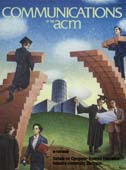March 1985 - Vol. 28 No. 3

Features
Excerpts from: An Information Systems Manifesto
James Martin talks with Leonard Kleinrock about the state of the art in data processing—how corporate and MIS managers should manage the new technology, and how computer science education should relate to it.
Predicting performance in an introductory computer science course
A group of 269 first-semester freshmen was used to predict both performance in an introductory computer science course and first-semester college grade point average by using information regarding the students' programs and performance in high school along with American College Testing Program (ACT) test scores.
Computer science in secondary schools: curriculum and teacher certification
Computer science in secondary schools is an area of increasing interest and concern to educators as well as to computer science professionals. Each of the next two reports addresses an issue of major importance regarding computer science in secondary schools. The first report recommends computer science courses for the secondary school curriculum, and the second report recommends requirements for teacher certification in computer science.In 1983 the ACM Education Board initiated efforts to formulate recommendations for secondary school computer science. Two task forces, one for curriculum recommendations and the other for teacher certification recommendations, were established under the Education Board's Elementary and Secondary Schools Subcommittee. The work of the two task forces was also supported by the IEEE Computer Society Educational Activities Board, and the final reports from the task forces were jointly approved by the ACM and IEEE-CS boards in July 1984. Thus the reports are significan't not only for the important issues that they address, but also because they represent a joint activity between ACM and the IEEE Computer Society.The work of the two task forces is summarized in the next two reports. The full reports are available as the publication Computer Science in Secondary Schools: Curriculum and Teacher Certification, Order Number 201850, from the ACM Order Department, P.O. Box 64145, Baltimore, MD 21264.
A system for interactive viewing of structured documents
An existing typesetting system is tied by bridging software to an existing page-presentation program to effect both hard (typeset) copy and interactive browsing. The typesetting system formats documents for a variety of output devices, and the “browsing” feature appears to the user as simply another output device that happens to be interactive.
An evaluation of retrieval effectiveness for a full-text document-retrieval system
An evaluation of a large, operational full-text document-retrieval system (containing roughly 350,000 pages of text) shows the system to be retrieving less than 20 percent of the documents relevant to a particular search. The findings are discussed in terms of the theory and practice of full-text document retrieval.
Designing for usability: key principles and what designers think
This article is both theoretical and empirical. Theoretically, it describes three principles of system design which we believe must be followed to produce a useful and easy to use computer system. These principles are: early and continual focus on users; empirical measurement of usage; and iterative design whereby the system (simulated, prototype, and real) is modified, tested, modified again, tested again, and the cycle is repeated again and again. This approach is contrasted to other principled design approaches, for example, get it right the first time, reliance on design guidelines. Empirically, the article presents data which show that our design principles are not always intuitive to designers; identifies the arguments which designers often offer for not using these principles—and answers them; and provides an example in which our principles have been used successfully.
Pricing computer services: queueing effects
This article studies the effects of queueing delays, and users' related costs, on the management and control of computing resources. It offers a methodology for setting price, utilization, and capacity, taking into account the value of users' time, and it examines the implications of alternative control structures, determined by the financial responsibility assigned to the data processing manager.



